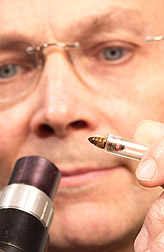| 
Entomologist John Harbo prepares a queen bee for
artificial insemination. Click the image for more information about
it.
Read the
magazine
story to find out more.
|
Trait in
Honey Bees Keeps Mites From Multiplying
By Erin Peabody
May 12, 2004 For more than 20 years, beekeepers have
been battling varroa mites. The tiny, bloodsucking parasites weaken adult bees
and sometimes cause deformities. But entomologists with the
Agricultural Research Service have
discovered that some bees have a built-in defense against varroa mites, a trait
that can be bred into any bee population.
Honey bees deliver pollen necessary for the production of $15 billion worth
of U.S. crops. Varroa mites are a serious threat to this important,
bee-dependant productivity and can wipe out an untreated colony in under two
years.
Called SMR, for "suppressed mite reproduction," the newly-found
trait protects bees by keeping harmful varroa mites from reproducing. It's
hoped that when adequately bred into bee populations, SMR can one day free
beekeepers from their dependance on chemical miticides.
ARS entomologists John R. Harbo and Jeffrey W. Harris, in the agency's
Honey Bee
Breeding, Genetics and Physiology Research Unit at Baton Rouge, La.,
discovered the SMR trait while searching for the reason behind reduced mite
populations observed in some bee colonies. While honey bees can fend off mites
through grooming and other hygienic behaviors, a different factor appeared to
be at play in those colonies.
The researchers found that some mites simply weren't reproducing. They
watched female mites entering brood cells--the small pockets, or honeycomb,
where young bees develop--but not laying any eggs. Following genetic studies,
the researchers determined that a trait in these honey bees was responsible for
inhibiting the mites' reproduction.
To help beekeepers whose hives are suffering from varroa infestations, ARS
has provided the SMR trait to Glenn
Apiaries, a commercial queen honey bee producer in Fallbrook, Calif., that
sells SMR breeder queens. With selective breeding, the SMR trait can eliminate
mite reproduction in worker brood cells.
Harbo and Harris are studying a second trait in bees linked to mite
resistance. Called P-MIB, for "percentage of mites in brood," the
trait is an ideal complement to SMR because it curbs mite populations from
outside, rather than inside, the brood cell where SMR comes into play.
Read
more about this research in the May issue of Agricultural Research
magazine.
ARS is the U.S. Department of
Agriculture's chief scientific research agency.
|